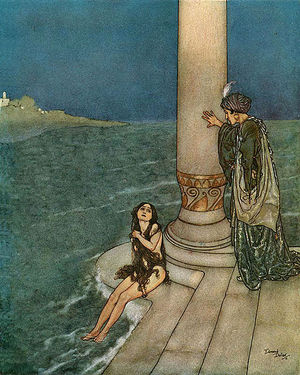The Little Mermaid as we know it today is one of the most bastardized adaptations in the history of fairy tales. While Disney is not known for it’s accuracy and loyalty to the original texts, it’s version of The Little Mermaid can hardly be called the same as the story Hans Christian Anderson first published in 1837.
The Little Mermaid (Anderson never gives her a name) is the youngest of six mermaid sea-princesses. They live in the castle of the widowed sea king with their father and grandmother. Once a mermaid reaches the age of 15, she can swim up to the surface and see the wonders of the land. The little mermaid has to wait anxiously as her sisters all go up to the surface and return with beautiful stories. This is a shame because the little mermaid seems to be the most in love with the land and humans, she even keeps a statue of a boy that fell into the ocean.
When it’s finally the little mermaid’s turn, she rises to the surface and sees a prince celebrating his birthday aboard a ship with fireworks. The little mermaid immediately falls in love with the prince, and when the ship begins to sink she rescues the prince. As she swims with the prince to land, she leaves him at a temple and watches as a beautiful young girl discovers him and takes care of him. Sadly, the prince never realizes that the little mermaid is the one who saved him, and believes the temple girl to be his rescuer.
The little mermaid returns to the sea, desolate at the result of her saving the prince. She asks her grandmother if humans can live forever if they don’t drown in the sea, and her grandmother responds by saying that human beings have a shorter lifespan than mermaids, but possess an immortal soul, which allows them to live eternally in heaven. She tells the little mermaid that when a mermaid dies, they just turn to sea foam. The little mermaid is very upset by this answer and goes off to see the sea witch.
The sea witch makes a deal with the little mermaid. She will give the little mermaid legs in exchange for her tongue, and the little mermaid will be a wonderfully graceful dancer, but it will feel as though she is dancing on knives every time. The little mermaid hesitates because she has the most enchanting voice of any creature, above or below the sea, but she takes the deal. The sea witch cuts out her tongue and gives her a potion which will (painfully) turn her fish tail into human legs.
The little mermaid goes to shore and drinks the potion. She impresses the prince by dancing, despite the excruciating pain, and is soon the prince’s favorite companion. The little mermaid tries her hardest to make the prince fall in love with her, but he only loves the little mermaid like a sister. This is unfortunate because if the prince marries someone else, the mermaid will die and turn to sea foam. On the day his father says he is to marry the daughter of a neighboring king, the prince says he would rather marry the little mermaid but must go and visit his betrothed princess. Upon seeing the princess, he discovers that it is the temple girl and decides to marry her immediately.
But all hope is not lost! The little mermaid’s sisters appear with a knife given to them by the sea witch. If the little mermaid wishes to turn back into a mermaid, she must kill the prince and let his blood drip on her feet (I can’t imagine why Disney left this part out!). The little mermaid decides she can’t do it, but instead of dying she is turned into a “daughter of air,” which was Anderson’s way of bribing children into behaving. Daughters of air are spirits which preform 300 years’ worth of good deeds in exchange for and immortal soul. Every time they find a good child one year is removed, while bad children cause the daughters of air to cry and add one more day to their sentence.
If you leave out the ending that doesn’t fit with the rest of the story (Anderson’s original story ended with the mermaid dissolving into the sea), the story is a vastly different tale from the one Disney tells. The little mermaid sacrifices everything for love and an immortal soul and still fails in her quest. The story’s basic moral is that no matter what you do, nothing is ever good enough. Of course, that’s not a very good ending for a child, so he added the daughters of air thing and told children that if they’re very, very good, a mermaid will get her soul. Hans Christian Anderson: guilting children into good behavior over a hundred years before Disney.
Read Anderson’s original story Here.


